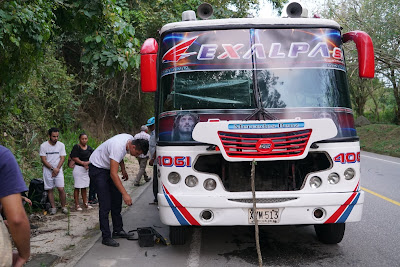Children of Earth
So it’s the usual sad story: the conquistadores saw natives with gold, land, women and children, they wanted the gold, land, women and children. Strangely, the natives were unwilling to give these away, violence ensued, then death - especially of the natives. Only there’s a twist in the plot. Here in the Santa Marta region of Magdalena the Sierra Nevada mountain range plunges pretty much straight into the sea (45km inland are peaks, which are 5800m, a gradient comparable with the south face of the Himalaya and unequalled along the world’s costs - or so the guide books would have us believe).So the natives remaining after the initial massacres had higher ground to withdraw to and avoid total annihillation.
The natives, in this instance, were the Tayrona people, one of the most important in pre-colonial Colombia, who settled in the mountains and became the Kogi people.
Though no longer living on the coast, the Kogi people still have authority of a region of jungle and paradise beaches stretching 85km along the coast - the Tayrona National Park. It’s a region of great spiritual significance to the indigenous cultures of today, as it was for generations of their ancesters. As Christian nations would say: God’s own country. Therefore the Kogi people close the park once a year for a month for spiritual cleansing purposes - and that month starts 28th January. So I made it there in the nick of time.
For the Kogi, the Great Mother is the creator figure and the driving force behind nature. The earth is a living being and they are its children. They believe our actions of exploitation, devastation and plundering are weakening the Great Mother and leading to our destruction. Most scientists seem to agree.
So in Tayrona nature is revered and respected, creating a national park, where movement is limited to certain paths and outside these, there is uninterrupted jungle and thriving wildlife.
I saw several families of monkeys and joy of joys - my first sloth! He was too far to take a photo, but I enjoyed about five minutes of hectic sloth activity as he reached out his paw, looked around once and took a step. Everything in glorious slow motion. Unfortunately his step took him behind a branch, but it was great while it lasted.
I saw several families of monkeys and joy of joys - my first sloth! He was too far to take a photo, but I enjoyed about five minutes of hectic sloth activity as he reached out his paw, looked around once and took a step. Everything in glorious slow motion. Unfortunately his step took him behind a branch, but it was great while it lasted.
And then there are the beaches. 85km of white sandy bays with no rubbish and very few people. Unfortunately their beauty is trecherous: Most of the coast has vicious rip tides and strong waves breaking - and a sobering sign on the beach next to red flags reads: ”Forbidden to swim in these waters. More than a hundred people have drowned here. Do not become part of the statistics”. And yet apparently every year some likely lad tries his luck with the waters, and the waters win.
There are one of two bays where it’s more or less safe to swim, but even here the force of the waves was impressive.
There are one of two bays where it’s more or less safe to swim, but even here the force of the waves was impressive.
However mostly it’s miles of pristine coast as in the image above, with a choice of the deadly rip tide sea on the left or a fresh water lagoon on the right - with signs warning that alligators live in it.
But it was beautiful! One of those ”most beautiful beach in the world” contestants.
On the way back from the park to civilization our bus broke. This is a very common occurance in many countries and usually, as in this instance, ten or so minutes of tinkering by the driver and the bus assistant will have us back on the road. I started thinking of some of the broken bus episodes I’ve had: Venezuela, Bolivia, the Turkey to Syria bus (an epic - we broke down 5 times and the 2-hour bus ride became a 5-hour bus ride). But not once in South-East Asia that I can recall, even though the buses certainly aren’t any newer or fancier. Maybe a different culture, where buses are actually maintained, rather than fixed when they break?














Comments